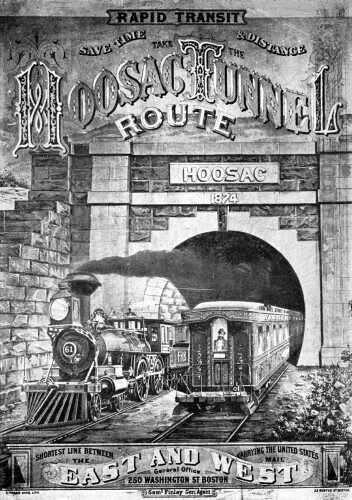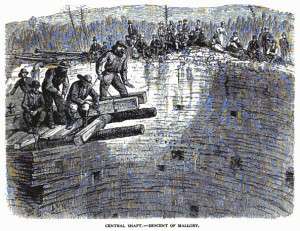The Hoosac Tunnel disaster killed 13 miners in 1867, but the tunnel took the lives of an estimated 180 workers during decades of construction.
All those lost lives convinced some workers the Hoosac Tunnel had a curse on it. Some walked off the job. Stories of unexplained lights and strange mournful sounds prompted a cavalry officer to investigate. He emerged from the tunnel saying he hadn’t been that frightened since Shiloh.
The Hoosac Tunnel cost considerable treasure as well as lives. Its critics, including future Supreme Court Justice Supreme Court Justice Oliver Wendell Holmes, Jr., called it ‘The Great Bore.’ Workers called it ‘The Bloody Pit.’
But to its supporters, the 4.75-mile railroad tunnel in western Massachusetts provided a crucial link from New England to the west.
Hoosac Tunnel Beginnings
The mill owners of Massachusetts had their eyes focused on the west as far back as the early 1800s, and they dreamed of a way to make shipping products easier. But it was only a dream. The Hoosac mountain range stood in between them and the cities to the west.
First the mill owners talked of building a canal system to carry people and product farther inland. That dream gave way to hopes for a railroad.
As the demand grew, the state began thinking about building a tunnel through which trains could travel west to Albany. In 1851, workers began tunneling under the mountains between the two Massachusetts towns of North Adams and Florida.
The Civil War started and ended while the tunnel was under construction. Twenty-four years after work began, the Hoosac Tunnel opened. It quickly became one of the most popular train routes in New England, with 40 trains a day passing through what was then the longest tunnel in the country.
But the success of the Hoosac Tunnel came at considerable expense — $20 million and nearly 200 men’s lives went into its construction. Work started and stopped many times as the public grew upset at the expense. Holmes said he’d like to ‘wall up a dozen lawyers at one end of the tunnel and put a good fee at the other.’
Having a Blast
Tunneling technology vastly improved over the life of the project, as workers used improved new drills and black powder gave way to nitroglycerin for blasting.
 On March 20, 1865, three explosives experts decided to blast with nitroglycerin. They placed the charge and ran back toward a safety bunker. Two men never made it. The third man, Ringo Kelley, set off the charge before the others reached the shelter.
On March 20, 1865, three explosives experts decided to blast with nitroglycerin. They placed the charge and ran back toward a safety bunker. Two men never made it. The third man, Ringo Kelley, set off the charge before the others reached the shelter.
Soon after the accident, Kelley vanished. Some suspected he deliberately set off the nitroglycerin. Two months later, workers found his body inside the tunnel — at almost the exact place the other two died. Authorities concluded someone strangled Ringo Kelley, but they never found a suspect. Rumors flew that spirits killed him in revenge for the murder of the other two men.
The Longest Day
The worst day on the project came when the Hoosac Tunnel disaster killed 13 men.
Just after noon Saturday, Oct. 17, 1867, 13 men descended into the tunnel’s central shaft. Men were tunneling from both east and west ends of the tunnel. The 13 workers were constructing the central shaft to ventilate the completed tunnel.
A building sat atop the shaft. It contained flammable materials, everything from oil to power lamps to the explosives that would be lowered into the shaft for blasting. The building also contained gasoline that had been tried as a method for lighting the shaft, but deemed too dangerous.
A spark set off an explosion in the building and flames quickly enveloped it. The four men inside had to evacuate. They hadn’t time to try to bring the workers up from the shaft, nearly 600 feet deep.
They wrestled in vain to extinguish the fire, but soon after it started the building collapsed. The men below were showered with rigging equipment, mining tools and debris.
In the days that followed, Thomas Mallory was lowered into the central shaft several times to look for survivors. Before he took his first trip down, he made out his will. He would be pulled to the surface nearly passed out from lack of oxygen and report that no one could survive.

Eastern entrance of the Hoosac Tunnel in 2013.
With no working pumps for air or water, the shaft soon began filling with water. It would be a year before the rescuers could reach the men below. When they did, they found that they had survived for some time. They had built a crude raft to try to float atop the flood waters, but died from asphyxiation.
Hoosac Tunnel Ghost Sightings
According to folklore, ghosts haunt the Hoosac Tunnel. Some of the ‘sightings‘ include:
- In 1868, a cavalry officer and engineer named Paul Travers examined the tunnel because the workmen complained of hearing a man’s voice cry out in agony. He heard what sounded like a man groaning out in pain. “I haven’t been this frightened since Shiloh,” he wrote.
- Before the 13 miners’ bodies were found, villagers told stories of vague shapes and wails near the pit. Workmen said they saw apparitions of the lost miners carrying picks and shovels through the mist and snow on the mountains.
- After the miners’ bodies were recovered, the apparitions disappeared but workmen kept hearing eerie moans.
- In 1874, a hunter named Frank Webster vanished near the Hoosac Tunnel. A search party found him three days later in a state of shock. He said strange voices ordered him into the tunnel, where ghostly figures wandered around and invisible hands took his hunting rifle and beating him with it.
This story was updated in 2021. Image of east entrance to Hoosac Tunnel By Doug Kerr from Albany, NY, United States – Hoosac Tunnel – Massachusetts, https://creativecommons.org/licenses/by-sa/2.0/legalcode CC BY-SA 2.0, https://commons.wikimedia.org/w/index.php?curid=51619114.




5 comments
Rick Sally
Amazing place with lots of energy! I’m a freight Conductor with Pan Am Railways and travel through Hoosac 5-6 days a week on my run between Ayer Ma and Upstate NY. I’m still amazed every time I go through it!
Cool post. Keep them coming.
Love this story. Very informative.
[…] For more info on the ghostly sightings you can read the blog on American Hauntings Ink. Or the New England Historical Society. More historical info on the tunnel is at American Rails. You can visit the Hoosac Tunnel Facebook […]
Comments are closed.